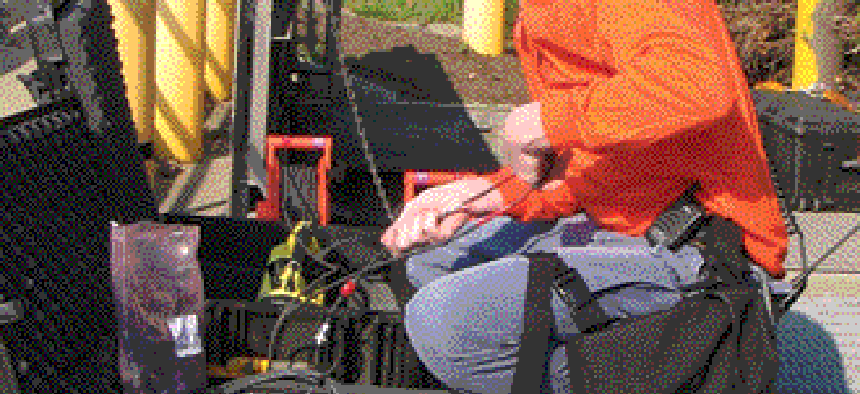Comms in a box

D.C. area turns to radio-bridging device to connect disparate first responders.
Sandwiched between Maryland and Virginia, the area surrounding the District of Columbia is home to several county, state and federal first responders."If we were to have an act of terrorism or some other crisis in the District of Columbia, there are many police forces that have overlay jurisdiction in the metropolitan area, and they would respond," said John Freeburger, a project manager of the Office of National Capital Region Coordination's resources group, assigned to Montgomery County, Md., Fire and Rescue, and event manager for the National Capital Region Radio Cache Project.A fire deep in one of Washington's subway tunnels, for example, could attract police from Prince Georges County, Md., fire departments from Montgomery County and various federal agencies. And in many cases, responders would arrive with radio systems that are not interoperable with one another.To ease that problem, local agencies have deployed several tactics, including making standards for new radio systems and buying a cache of preprogrammed radios to hand out in a crisis. Because buying a new radio system is not in the budget for some jurisdictions, and handing out radios isn't always practical at a major incident, the radio cache project acquired technology that bridges otherwise noninteroperable systems.The project chose the Incident Commanders' Radio Interface from Communications-Applied Technology Inc. of Reston, Va. The unit bridges military and civilian radios; cell, satellite, direct-connect and land-line phones; and trunked and conventional radios. It also supports voice over IP communications and complies with standards of the Homeland Security Department's Office for Interoperability and Compatibility for its Safecom communications program.C-AT's units range between seven and 20 inches long. One radio or phone is plugged into the unit for each system that needs to be bridged. For example, a police force's digital radio, a fire department's analog radio and a federal agent's cell phone might be plugged in to let those from the three groups who are within range communicate with each other.C-AT developed the technology for a tactical military environment, said Seth Leyman, company founder and president."All of our projects are related to the kind of environment where untrained personnel need to deploy quickly and under extreme circumstances," he said. ICRI was developed "with the concept of simplicity of operation, minimal current drain and widest possible range of input voltages and ruggedness."U.S. Customs and Border Protection is using the technology to connect dissimilar radios in remote areas. Border agents may be working in an area with no infrastructure, but they can communicate via an ICRI unit mounted in one of their vehicles. The agents might be using 800-MHZ radios while nearby state police use very-high-frequency, low-band radios, but they can communicate with each other via ICRI."You have two completely incompatible radios, but they are both reaching back to bridge," Leyman said. "Even though they are on totally different frequencies, they are talking to each other."If users want to communicate at the same time with their remote command units hundreds of miles away, they could do so by plugging a satellite radio into ICRI. Then everything the state police or border command unit official says can be broadcast.ICRI takes the audio from an incoming signal and "keys" it to any other device plugged into it via voice-activated circuits. Because ICRI connects only via the audio path, it avoids interoperability hurdles."Your voice reaches our box from your radio, we take the audio and make sure it's at a good level, and then it passes to the other radios and keys those simultaneously, so everybody gets your information," Leyman said.Using the system requires some pre-planning; each responding force would have to contribute one of their radios to use with the box to create the bridge. And it's important to ensure that no other bridge in the area is using the same frequency.Systems integrators often use the technology as one layer in a communications bridging solution, Leyman said. It has been installed in mobile units that have IP bridging systems, which may be a better fit for some incidents.The Washington regional group is also using ICRI as a tactical repeater, which connects and extends radio frequency coverage in areas such as a mall or subway tunnel."The firefighters know if they go underground and a repeater system installed down there is knocked out, we would turn to an analog system," Freeburger said. "With ICRI, I can grab one radio and put it down an airshaft, and I'll be able to capture a weak signal."The tactic would let firefighters get reconnected quickly with commanders above ground. Should medical personnel go down to respond, another cable could be sent down to tie their radios to the commanders' radios. With both signals available at a command post equipped with an ICRI box, communications systems could be patched together.If you have an innovative solution that you installed in a government agency, contact Staff Writer Doug Beizer at dbeizer@postnewsweektech.com.


DCPR LLC
NEXT STORY: Ready, set, go: DHS mega deals

